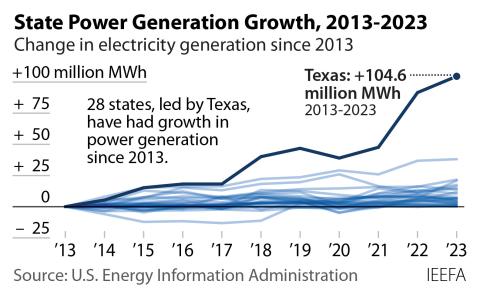FirstEnergy seeks a subsidized turnaround
Download Full Report
Key Findings
FirstEnergy’s distribution utilities serve 6 million customers, and FirstEnergy’s retail energy supplier (FirstEnergy Solutions) serves 2.6 million customers.
FirstEnergy’s financial condition has deteriorated since it merged with Allegheny, and its key financial metrics are on a downward trajectory. Declining stock prices, declining revenues, declining net income, rising debt levels, reduced dividends and an overreliance on stop-gap, short-term financial measures all flow from the underlying condition that the company’s business – the sale of electricity – is performing poorly.
At the core of this weakness is the inability of FE’s leadership to consistently bring recurring revenues into alignment with recurring expenses.
Executive Summary
FirstEnergy is one of the largest electric utility holding companies in the country. Its distribution utilities deliver electricity to approximately 6 million customers in Ohio, West Virginia, Maryland, Pennsylvania, New Jersey, and a very small area of New York. FirstEnergy owns both merchant power plants, which sell their output into regional wholesale electricity markets, and regulated power plants, which recover their operating costs directly from electricity customers. FirstEnergy’s regulated power plants are all owned by its West Virginia subsidiary Monongahela Power.
The company’s strategy has involved heavy reliance on coal generation. FirstEnergy increased its exposure to coal in 2011 with its merger with Allegheny Energy, a company 78% dependent on coal. With an aging coal fleet, low natural gas prices driving down power prices, weak electric demand growth, and increasing penetration of energy efficiency and renewable energy, this has not been a winning strategy. FirstEnergy’s merchant power plants, which depend on being able to sell their output for more than their cost of operation, have been hit particularly hard. Indeed, a leading utility analyst has recently estimated that FirstEnergy Solutions, one of FirstEnergy’s merchant generation companies, is worth less than $0.
FirstEnergy’s financial condition has deteriorated since it merged with Allegheny, and its key financial metrics are on a downward trajectory. Over the past three years, it has experienced declining revenues, declining net income, declining stock price, declining dividends, and rising debt. It has retired 4,769 MW of merchant coal plants and has booked impairments totaling $1.1 billion against the value of its coal plants from 2011 to 2013. To shore up its balance sheet, FirstEnergy has relied heavily on “one-time resources,” including proceeds from asset sales and short-term borrowings. FirstEnergy’s poor financial performance stems from the underlying condition that the company’s business – the sale of electricity – is performing poorly and not generating sufficient revenue to cover expenses.
FirstEnergy is burdened by heavy reliance on an underperforming merchant coal fleet in a weak competitive market and a regulated coal plant portfolio that is profitable but unable to carry legacy debt and likely additional environmental retrofit costs.
FirstEnergy’s aggressive political and regulatory strategy is one way in which the company has sought to compensate for its declining financial performance, often at the expense of ratepayers and taxpayers. For example, in 2013, FirstEnergy successfully transferred the Harrison coal plant from a merchant subsidiary to a regulated subsidiary, ensuring that West Virginia electricity customers will pay for the plant’s costs for the remainder of its useful life. In Ohio, FirstEnergy has been exposed for driving up prices for renewable energy credits charged to Ohio customers and for failing to bid energy efficiency resources into the regional capacity market, a move which cost consumers several hundred million dollars.
FirstEnergy’s latest proposed regulatory bailout is its pending request to the Public Utilities Commission of Ohio asking ratepayers to subsidize the continued operation of its W. H. Sammis coal plant, its Davis-Besse nuclear plant, and its share of the OVEC coal plants. FirstEnergy is requesting that its Ohio distribution utilities be allowed to enter into a fifteen-year contract to purchase the output of these plants at a price that significantly exceeds wholesale electricity market prices. Ohio electricity customers will pay for the difference.
This move is simply the latest in a long series of moves to ensure the continued subsidization of FirstEnergy’s coal fleet. Yet, despite its political and regulatory strategy, pursued at the expense of ratepayers and taxpayers, FirstEnergy has not succeeded in improving its core financial metrics or bringing rising debt levels under control. We do not anticipate any significant short-term or medium-term improvement in FirstEnergy’s financial condition.
Please view full report PDF for references and sources.
Press release: Report: FirstEnergy Seeks a Subsidized Turnaround













